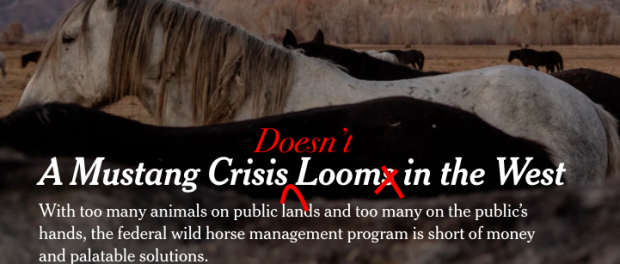CORRECTIONS WATCH
Fact-checking The New York Times: Sources claim wild horse damage, but photos show cattle did it.
NYTimes editors ignored facts and photos submitted by a western environmental group, declining to correct an error-filled story.

On 4/6/2020, the director of the environmental group Western Watersheds Project submitted a second corrections request to the New York Times for this article. (You can read the first request here).
Times editors did not respond.
Dear Editors,
A factual correction is needed for the article titled, “A Mustang Crisis Looms in the West” (David Philipps, March 22, 2020).
“Bureau officials warn that the mustang herds are a looming catastrophe for the land”
The article misleadingly states,
“Bureau officials warn that the mustang herds are a looming catastrophe for the land”
— a completely fictional statement that should have been fact-checked, failing to take into account (and report) that the number of cattle (and therefore their impacts) affecting western lands (public and private) year-round is 50 times greater in the West than the number and impacts of wild horses.
The article also quotes a rancher, who likewise attributes habitat degradation to wild horses that is caused instead by domestic livestock:
“On the edge of the wild horse range in Challis in central Idaho, Jackie Ingram, a rancher, has shared 168,700 acres of public land with the mustang herds for 46 years. Each spring her family drives hundreds of Black Angus cattle up a steep road through Spar Canyon to graze the high, windswept hills on Bureau of Land Management land. In some years, she said, the wild horses left so little grass to eat that other wildlife disappeared, and her family had to cut back their cattle herd.”
Wild horses are not causing these land health problems; domestic cattle — under the management responsibility of the BLM — are. These factual errors would readily have been remedied had the New York Times contacted an environmental group for a perspective on environmental status, instead of the BLM and the livestock industry — who are the culprits causing the degradation of rangeland health in this particular area — to get a perspective on what is causing the land health problems in the area inhabited by the Challis wild horse herd.
As it happens, Western Watersheds Project is headquartered in the mountains of central Idaho, and has deep expertise in both rangeland health issues (we’re the leading conservation group nationwide working on this issue) and the lands that are the particular focus of this article.
At WWP’s last annual meeting (June 2019), our full staff toured lands where the Challis wild horse herd lives. Areas shared by cattle and horses were in very poor condition due to overgrazing, but areas with no cattle and only wild horses were in good condition, and bluebunch wheatgrass (a ‘decreaser’ in the face of grazing pressure) was making a strong comeback.
For your reference, I have attached two representative photographs taken in June 2019 in the Challis wild horse herd area.


The photo on the left shows a federal grazing allotment on Horse Basin Creek in the East Fork Salmon River watershed where cattle and wild horses graze. This is a north exposure, which has a cooler wetter microclimate that would typically support a lusher growth of foliage.
The photo on the right shows an area lower in the Horse Basin Creek drainage that is outside livestock grazing allotments, but is grazed by wild horses of the Challis wild horse herd. This a south exposure, hotter and drier with less favorable growing conditions. Interestingly, you can see the same jet contrail in both photos.
As you can clearly see, the ecological impacts of wild horses are insignificant with the heavier impact of cattle removed from the equation.
For the record, I am a wildlife biologist and have published peer-reviewed science on the ecological effects of large herbivores on plants and ecosystems.
Please let me know what you plan to do regarding corrections.
I will look forward to your response,
Erik Molvar
Executive Director
Western Watersheds Project
Please leave a comment below, follow me @viglet on twitter and read these other Daily Pitchfork posts pushing mainstream news outlets to correct their errors:
Fact-checking 13-year old photographic images in the Washington Post (1/22/21)
Fact-checking 9 errors in the Washington Post, Seattle Times and Houston Chronicle (12/12/20)
Fact-checking errors and omissions in the New York Times (12/12/20)
Fact-checking the New York Times: Maps and data expose cattle, not wild horses, as looming crisis. (12/15/20)

Horses have grazed this land for many years without harming the eco system, they eat a little and move on. Cattle on the other hand will eat until nothing is left, then move to another area.
The land belongs to the horses that have lived there for hundreds of years unlike cattle. Cattle do not belong where the horses roam. DOWN WITH THE PURCHASE OF ANY BEEF PRODUCTS!!
Thank you for your efforts to tell the truth about our public HMA ranges. Too many cows is a big problem on public lands.
Thank you for your efforts to tell the truth about our public HMA ranges. Too many cows is a big problem on public lands.My dad and grandfather were cattle men and always rotated grazing on their on lands.
This is a war against our wild horses! Greedy ranchers want OUR public land to make more profit for themselves, and the wild horses are in the way!!
These herds have managed themselves for hundreds of years, without totally destroying the land they graze. Cattle on the other hand eat everything down to the dirt!
When will the ranchers be satisfied? How much land is enough for them? Like most laws,
Raise your cattle on YOUR land! Leave our public land to the animals that call it home!!